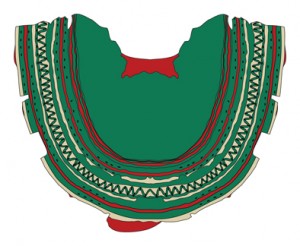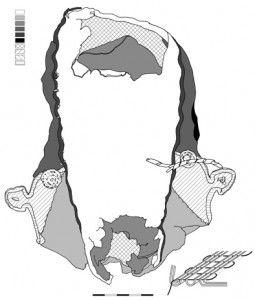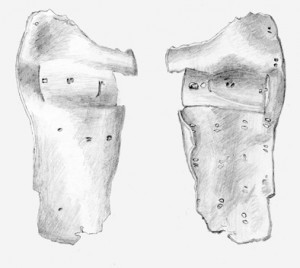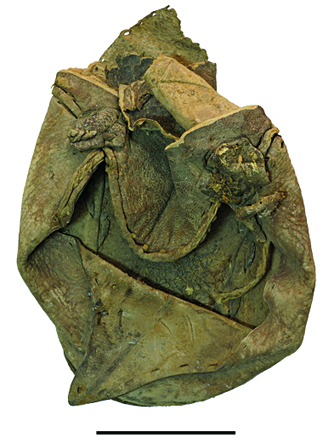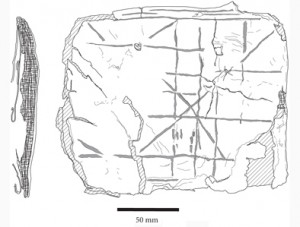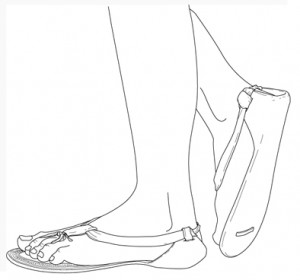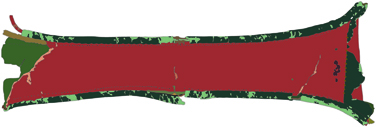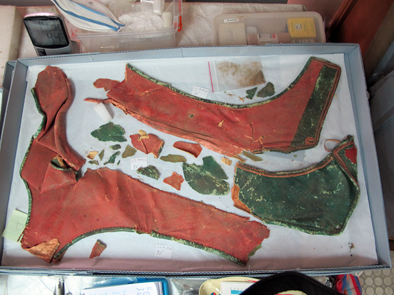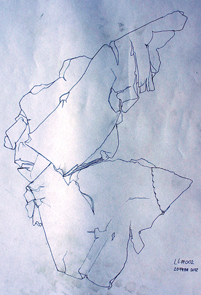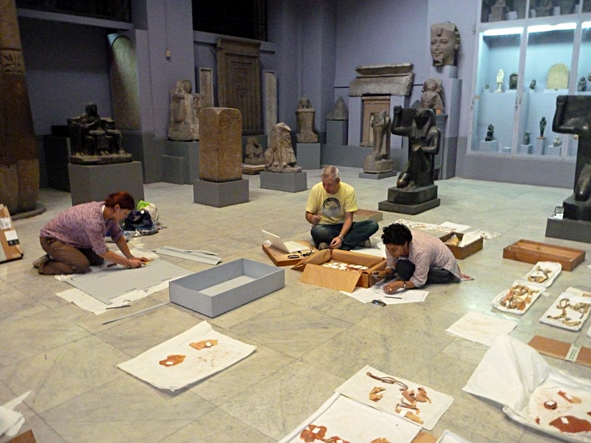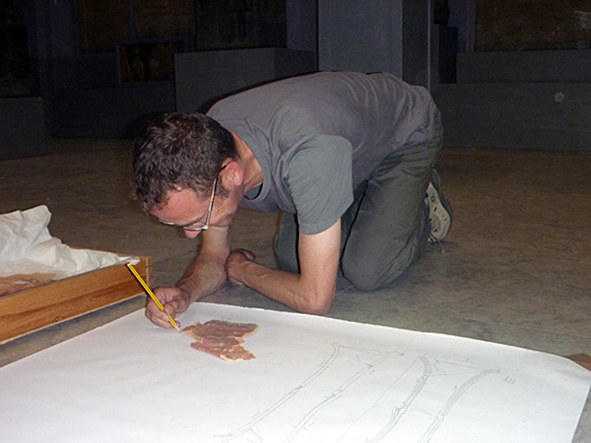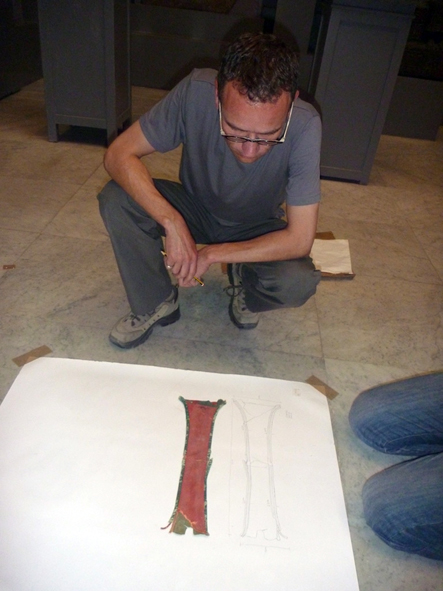The Ancient Egyptian Leatherwork Project (AELP) consists of several sub-projects, each of which deals with the leatherwork from a specific site (e.g. Tell el-Amarna). Co-directed by Dr. André J. Veldmeijer and Prof. Dr. Salima Ikram.
[spoiler]
(text adapted from Amarna’s Leatherwork. Part I. Preliminary Analysis and Catalogue)
Objectives
The overall aim of the research into leatherwork is to determine the position of leatherwork in the individual setllements, for the Egyptian civilization at large, and more specifically to determine which factors were responsible for the apparent increased importance of leatherwork in the 18th Dynasty. The research will eventually combine the information obtained by iconographic and philological studies as well as experimental archaeology and chemical analyses, with the above-mentioned studies of the archaeological finds.
In short, the research has two components: I) the material culture and II) socio-cultural aspects. Before being able to interpret artefacts and determine socio-cultural aspects, a thorough insight into the product and its manufacturing process is necessary (material culture).
I) The research into material culture has three focal points:
- What kind of skin was used and how was it processed into leather?;
- Understanding the manufacturing technology. The focus is on the objects, the study of which includes stitching, seams, cutting patterns and decoration;
- The leatherworkers and their workshops including the tools. What do workshops look like and how can they be recognised in the archaeological record? If we recognise them, the information obtained from such spaces and tools needs to be combined with that from the leather artefacts themselves to elucidate production processes. This, however, will be discussed only in passing, as the present catalogue does not include tools and archaeological traces of the leather workshops.
II) Socio-cultural aspects is a rather broad and loosely defined term, which includes topics such as the interpretation of the objects, the value of leatherwork within the community and society at large (in both a monetary and aspirational sense) and the organisation and status of the leatherworker. Within these focal points, there are several points of interest. How were the artefacts used and how are artefacts and their production to be interpreted? Is there any indication as to long-term use, for example to be deduced from (many) repairs, or were some artefacts handled more carefully? This might be linked to the status of (some) leatherwork, but what status did leather and the various leather products have within the community? And what does this say about their possible owners, and, in broader perspective, the community? Indeed, there are indications that certain leatherwork indicates status: what can we say concerning the relative ‘wealth’ of the community on the basis of leather? How should we interpret the objects found in tombs: how does this relate to material from settlements? These questions all focus predominantly on the user, but socio-cultural aspects will deal with the manufacturing side as well and the status of the leatherworker is one of the topics that will be investigated as well as the organisation of the craft. What role did leather production play in the broader economic, administrative, and social networks? How do leather-production facilities relate to domestic, public and official spaces and how does the distribution of facilities compare with the distribution of leather artefacts? How does the leather industry relate to other industries?
The footwear, besides being analysed within the excavation’s theoretical framework as explained above, will also be analysed within the framework of the AEFP.[/spoiler]
Amarna
[spoiler]
Collections
Ägyptisches Museum und Papyrussammlung, Berlin
Petrie Museum of Egyptian Archaeology UCL, London
Excavations
Tell el-Amarna
Researchers
Principal researcher: Dr. André J. Veldmeijer (American University in Cairo/PalArch Foundation)
Artists/photographers
Ing. Erno Endenburg (PalArch Foundation)
Publications
See http://www.leatherandshoes.nl/andre-j-veldmeijer-cv/.[/spoiler]
Qasr Ibrim
[spoiler]
Collections
British Museum, London
Petrie Museum of Egyptian Archaeology UCL, London
Excavations
EES mission Qasr Ibrim
Researchers
Principal researcher: Dr. André J. Veldmeijer (PalArch Foundation, Amsterdam)
Researchers Pharaonic Period to the Age of Christianity: Dr. Carol van Driel-Murray (University of Amsterdam) / Dr. André J. Veldmeijer (PalArch Foundation, Amsterdam)
Artists/photographers
Ing. Erno Endenburg (PalArch Foundation)
Publications
See http://www.leatherandshoes.nl/andre-j-veldmeijer-cv/.[/spoiler]
Elephantine
[spoiler]
Excavations
Elephantine
Researchers
Principal researcher: Dr. André J. Veldmeijer (American University in Cairo/PalArch Foundation)
Artists/photographers
Ing. Erno Endenburg (PalArch Foundation)
Publications
See http://www.leatherandshoes.nl/andre-j-veldmeijer-cv/.[/spoiler]
Dra Abu el Naga
[spoiler]
Report Study Season
Introduction
During the 2012 season of the mission of the Deutsches Archäologisches Institut in Kairo (DAIK) to Dra Abu el-Naga, led by Dr. Daniel Polz, all leather (103 Fund Nummer, the majority of which consists of various fragments that have been sub-numbered using capital letters) has been registered. Registration included a basic description, measurements and technological sketches. Moreover, all material has been photographed. The objects were taken from their packing and adequately re-packed in acid-free tissue paper and appropriate containers to allow longer-term storage.
Besides the leather footwear, sandals that were made of other, vegetal material were studied, among which one near-complete sandal that has been identified as a sewn-edge fibre sandal. The sandal is still in good condition and shows signs of having been worn. The other non-leather footwear entries are only fragmentary and include half of a wooden tomb sandal. The finds have been treated in a comparable way as described above for the leatherwork.
Some Preliminary Observations
Overall, the finds make an interesting corpus of objects, representing a long period of time: possibly Middle Kingdom or early New Kingdom up to the Ottoman Period. To start with the large part of the shoe from the latter epoch: overall, it is very recognisable as an Ottoman shoe but many details differ nonetheless if compared with the large corpus of Ottoman shoes from Qasr Ibrim. Whether this is due to difference in time or space will be investigated.
Several pieces of footwear are of special interest. One small-size shoe is known from various collections but, unfortunately, unprovenanced. The find from Dra Abu al-Naga, therefore, could give important information on the dating of this, probably New Kingdom, type of shoes. A leather composite sandal is equally important, although not as much from a dating point of view but rather from a technological point of view: the strap construction confirms the construction seen only ones before. Two other entries of leather sandals will be helpful in more firmly date this type. Most of the footwear, interestingly, shows signs of actually having been worn.
The find of extremely thin leather turned out to be the cover of the sound box of the near-complete and beautiful harp. Since the leather seemed to have covered the decoration, it is assumed to have been transparent. Therefore, at first sight, it was suggested that the material must have been bladder but the presence of follicles prohibits such an identification. Several pieces of white, fairly thick leather, was found from within the same context. The identification as bag is clear, but whether it ones contained the harp cannot be confirmed as yet.
Future Work
In order to assure long term storage and preservation it is necessary to consult specialist conservators. Indications of deterioration are noticeable at various objects and, therefore, it is important that this will be organised in the near-future. The analysis of the results of the season’s work will be done within the framework of the mission’s theoretical framework as well as within the frameworks of the Ancient Egyptian Footwear and Leatherwork Projects.
Researchers
Principal researcher: Dr. André J. Veldmeijer (American University in Cairo/PalArch Foundation)
Lucy Skinner (conservation) in collaboration with the mission’s conservation team.
Artists/photographers
Ing. Erno Endenburg (PalArch Foundation)
Pieter Collet
Publications
See http://www.leatherandshoes.nl/andre-j-veldmeijer-cv/.[/spoiler]
Deir el-Bachit
[spoiler]
Excavations
Deir el-Bachit
Researchers
Principal researcher: Dr. André J. Veldmeijer (American University in Cairo/PalArch Foundation)
Artists/photographers
Ing. Erno Endenburg (PalArch Foundation)
Publications
See http://www.leatherandshoes.nl/andre-j-veldmeijer-cv/.[/spoiler]
Fustat
Introduction
A first, limited assessment of the leatherwork from Fustat shows that the bulk of material consists of footwear (mainly sandals and shoes). The pieces seen thus far, though brittle due to dehydration, are in fairly good condition, and the corpus does not seem to be in immediate danger of deterioration (save unchanged storage condition).
[spoiler]
In general there is a lack in footwear studies, but this is worsened by the fact that much material in collections lack provenance, seriously hindering analyses. Thus, finds from sound scientific excavations are desperately needed, emphasising the importance of the Fustat corpus: it fills a gap in the AEFP’s database and will, therefore, expand our knowledge on footwear (and leatherwork in general) throughout Egypt’s history, especially from the 8th century AD onwards. Although many of Fustat’s shoes and sandals are of known categories and types, the general lack of research makes the full study of the corpus of utmost importance to better understand the (development of) technology as well as changing preferences in time and space. Several extraordinary items increase the importance. For Fustat itself, the study can be of importance too: footwear has the potential to shed light on the society itself (besides the study of technology; viz. insight in health, prosperity and fashion).
Several published studies are of importance, despite the fact that much of these discussed objects are without provenance and dating: the finds from Fustat will help clarifying some of these finds. Comparison of material dated roughly to the same time will be possible, although some of these are (greatly) separated in space (among which is the material from the Christian layers of Qasr Ibrim and the finds from the Coptic monastery of Deir el-Bachit, all under study by the AEFP). Footwear housed in the Coptic Museum is important, but a first assessment of the collection will be done in the near future (see http://www.leatherandshoes.nl/coptic-museum/). Another source for comparison will be the finds from Antinopolis, which is partially published. Excavations of this site, however, are ongoing with the expectation that more finds will be recovered. Equally important will be comparisons with material even further separated in time and space. For understanding the broader development of footwear (development and distribution of technology and shape) comparisons with finds outside Egypt will be part of the overall research. These include finds from Europe: it is thought that some features rose in the Near East and found their way to Europe and Egypt.
Methodology
The study of the finds will be done within the framework of the Ancient Egyptian Footwear and Leatherwork Projects (AEFP and AELP respectively). Moreover, the results will be considered within the framework of the mission’s objectives. Initial work will focus on the study of the objects. In a later phase, other object categories will have to be considered: footwear was not only made of leather, but of a variety of materials, such as wood and fibres. Moreover, the presence of tools might shed light on leatherworking and/or the production or repair of footwear. Textual evidence will be included in the final analysis as well as iconography. Experimental and ethno-archaeological investigations might help elucidate the interpretation of the footwear and its dynamics in the broadest sense.
Planning
The initial work entails verbal description (including measurements) as well as producing a full photographic record (overviews and, if necessary, details). Further work consists of an assessment of conservation needs and first-aid conservation/consolidation and adequate storage, but excludes conservation/consolidation/reconstruction work: a plan by IFAO’s conservators and Lucy Skinner, the team member who is specialised in the conservation of leather, should be made. The first phase of the research also excludes more in-dept analysis such as the identification of the type of leather by chemical analyses (for example protein sequencing of the collagen using soft-ionization mass spectrometry) and, possibly, identification of the colour (methods being investigated, but XRF scanning has produced good results for leather). Moreover, the start of the work excludes the analysis of skin-processing techniques. Lists will be produced of those objects that have the potential to sample and investigate more in-dept to conduct such research. In other words, the first focus is on the manufacturing technology of the footwear, shape, use/wear/repair, forming a basis for further research.
Mission
IFAO, directed by Dr. Sylvie Denoix
Researchers
Principal researcher: Dr. André J. Veldmeijer (American University in Cairo/PalArch Foundation)
Conservator: IFAO/Lucy Skinner
Artists/photographers
Ing. Erno Endenburg (PalArch Foundation)
Publications
See http://www.leatherandshoes.nl/andre-j-veldmeijer-cv/.[/spoiler]
Gebel Adda (Royal Ontario Museum, Toronto)
[spoiler]
Excavations
Mainly ROM expedition to Gebel Adda.
Researchers
Principal researcher: Dr. André J. Veldmeijer (American University in Cairo/PalArch Foundation)
Conservator: Mary Peever/Lucy Skinner
Artists/photographers
Ing. Erno Endenburg (PalArch Foundation)
Publications
See http://www.leatherandshoes.nl/andre-j-veldmeijer-cv/.[/spoiler]
Proyecto Djehuty
Excavations
Spanish Mission Luxor, directed by Dr. José Galan (http://www.excavacionegipto.com/el_proyecto/campaigns.php)
[spoiler]
Researchers
Principal researcher: Dr. André J. Veldmeijer (American University in Cairo/PalArch Foundation)/Prof. Dr. Salima Ikram (American University in Cairo)
Conservator: Lucy Skinner
Artists/photographers
Ing. Erno Endenburg (PalArch Foundation)/Dr. André J. Veldmeijer (American University in Cairo/PalArch Foundation)
Publications
Forthcoming. The first season of work was in 2020; the work will continue in 2021.[/spoiler]
TT3
Excavations
Belgian Mission Luxor, directed by Dr. Laurent Bavay.
[spoiler]
Researchers
Principal researcher: Dr. André J. Veldmeijer (American University in Cairo/PalArch Foundation)/Prof. Dr. Salima Ikram (American University in Cairo)
Conservator: Lucy Skinner
Artists/photographers
Ing. Erno Endenburg (PalArch Foundation)/Dr. André J. Veldmeijer (American University in Cairo/PalArch Foundation)
Publications
Forthcoming. The work is planned for 2021.[/spoiler]
Live History of Theban Tombs (Luxor)
Excavations
Swiss Mission, directed by Prof. Dr. Susanne Bickel (https://lhtt.philhist.unibas.ch/project-staff-3/)
[spoiler]
Researchers
Principal researcher: Dr. André J. Veldmeijer (American University in Cairo/PalArch Foundation)
Artists/photographers
The mission’s photographer Matjaz Kacicnik.
Publications
Several publicaions are forthcoming.[/spoiler]
Egyptian Museum Chariot Project (EMCP)
[spoiler]
Introduction
During the 2008 season of the Egyptian Leatherwork Project in the Cairo Museum we came upon a cache of leather objects in magazine R2S on the Ground Floor of the Egyptian Museum (moved to Room 19, Ground Floor early 2009). The cache consisted of several trays of red and green leather containing some 60 large and numerous small leather fragments, all under a single JE and SR number (JE 88962; SR 14530). This acquisition was recorded on Dossier du Service 32-2/101 (which has yet to be found), purchased from the dealer Georges Tano in 1932.
Upon investigating the contents of these trays, we realized that they all came from a single chariot, including portions of the bow-case and quiver that were attached to either side. These last two objects are elaborately decorated in green and red leather. Based on the decoration of the leather and the technology used to achieve these effects, it seems to date from sometime between the late 18th Dynasty and the end of the 19th Dynasty: this needs to be further investigated.
The find is very rare and unusual: only a handful of complete chariots are known from ancient Egypt, and of these, only one heavily restored one in Florence, and that of Yuya and Tjuiu in the Egyptian Museum have any significant amount of leather, albeit largely undecorated, preserved.
Conservation
The conservators will make a detailed assessment of what work is necessary or possible, in conjunction with colleagues from the Egyptian Museum’s conservation department, after which the conservation process will be started. A brief, preliminary assessment in 2009 made clear that despite the excellent visible appearance, this is superficial: the collagen fibres have broken down to quite a dramatic level.
Two main concerns need to be addressed:
- the distortions (folds, creases) in some pieces, which cannot be unfolded
- the inherent fragility of the leather.
The following treatment is proposed: consolidation by means of solvent/polymer solution, which bond together the collagen fibres and reattach flaking surfaces. After consolidation the leather can be unfolded and distortions removed: if the leather is strengthened enough by consolidation, utilising the lubricating and softening effect of elevated humidity might relax the leather enough. Great care is needed in using water and extensive testing will be carried out prior to treatment. If water needs to be avoided altogether, the leather can be unfolded by inserting ethafoam blocks between the folds and gradually each day increasing the size of the blocks or introducing tiny weights to the leather to slowly flatten it out.
Storage/display
The leather will be distributed over several boards lined with acid free paper during the period needed to study the material. After conservation it will be clear whether piecing together the different parts of the chariot in order to reconstruct it is possible and only then will it be possible to develop a procedure to do so. If reconstruction is not possible, permanent museum storage approved case need to be provided for, which allows for storage in such a way that each fragment is stored without being in contact with other fragments.
Analysis
The leather will be unpacked, numbered and distributed over the boards lined with acid free paper. Either side of each fragment will be photographed in overview and in detail; appropriate sections will be drawn. The first study of the material, which includes a written description of the fragments, will result in a preliminary analysis of the manufacturing techniques, such as stitching and seams. Subsequent investigations will pay attention to the technologies used to make the chariot casing (preparing the leather, coloring it, methods of assembling the different parts into a casing, and the materials used). This includes identification of the type of leather by chemical analyses (protein sequencing of the collagen using soft-ionization mass spectrometry) and identification of the color (methods being investigated, but XRF scanning has produced good results for leather). The study of the most fragile and large pieces will be possible only after consolidation and conservation (see above) has been completed. At the moment, most of these pieces are folded and too fragile to unfold prior conservational work. After documentation and conservation, the process of putting together the fragments can be started, which will allow us to reconstruct the shape of the casing and the chariot itself.
The documentation and study of the leather will result in a detailed knowledge that allows for comparison with dated objects in the Egyptian Museum (Cairo), the Metropolitan Museum of Art (New York), and the Ägyptisches Museum und Papyrussammlung (Berlin) and which have been studied (and the Amarna material Berlin also published). The results of this comparison, together with iconographic studies of chariot- and leatherworking scenes, which will guide the reconstruction of the casing, further help to put the find in broader context.
Researchers
- Co-director and principal researcher: Dr. André J. Veldmeijer (American University in Cairo/PalArch Foundation)
- Co-director and principal researcher: Prof. Dr. Salima Ikram (American University in Cairo)
- Chief conservator: Lucy Skinner (Museum of Natural History and Archaeology, University of Science and Technology, Trondheim, Norway)
- Chariot iconography: Prof. Dr. Lisa Sabbahy (American University in Cairo)
- Chariot-related texts: Dr. Ole Herslund (University of Copenhagen)
- 1:1 scale model: Martin Moser
- Ibrahim el-Gawaad (Curator Egyptian Museum)
- Egyptian Museum’s conservation department
- Supreme Council of Antiquities
External advisors
- Dr. Carol van Driel-Murray (University of Leiden)
- Prof. Dr. Joost Crouwel (University of Amsterdam)
- Prof. Dr. Fredrik Hagen (University of Copenhagen)
- Archaeological Leather Group (England)
Artists/photographers
- Ing. Erno Endenburg (PalArch Foundation)
- Dr. André J. Veldmeijer (American University in Cairo/
PalArch Foundation)
- 2011. ARCE’s Antiquity Endowment Fund (USAID)
- Netherlands Flemish Institute in Cairo
- American University in Cairo
Publications by the research team
See http://www.leatherandshoes.nl/andre-j-veldmeijer-cv/.
- 2011. Article by Joanne Marchant: Ancient Egyptian chariot trappings rediscovered. – Nature (http://www.nature.com/news/ancient-egyptian-chariot-trappings-rediscovered-1.9388)
- 2012. Article by Theo Toebosch: Puzzel van 257 stukjes. – Elsevier 1: 64-65.
- Interview by Ancient Egypt Online: http://ancientegyptonline.org/egyptnews/p/aeo-interviews-and-veldmeijer-and-prof-dr-salima-ikram[/spoiler]
EMCP weblog
2011-2012 season: 12 March
Today, we were able to finish most of the drawings to allow us to reconstruct the chariot. Two more pieces remain, but these can only be worked on after being dealt with by Lucy Skinner. Salima has continued her work on checking our observations. Meanwhile, our draftsman, Mikko Kriek, had a first look on the chariot remains in the museum as well as on the depictions on stela.

Part of the team (from left to right): Salima Ikram, Ibrahim el Gawaad, Mikko Kriek and, in the back to the left, André J. Veldmeijer. © EMCP.
[spoiler]
2011-2012 season: 5 & 8 March
The two days were about the most productive thus far. We managed to finish most of the leather fragments that we think are necessary for a proper reconstruction of the chariot. Besides thus far unidentified but still important pieces with diagnostic edges, seems and decoration, we managed to draw large parts of the front of the casing of the body. These parts show deep fenestration whereas the possible side fillings show a large hole, the edge of which is nicely finished by a green binding.
2011-2012 season: Conservation report January-March 2012 (by Lucy Skinner)
Conservation work continues slowly but steadily on the larger sections of chariot leather. For the previous two weeks I have been concentrating on a folder containing a particularly three-dimensional piece. Once the top, highly decorated section was stabilised, partially repaired and carefully removed to a new tray, three further fragments were exposed underneath, in the same folder, which hadn’t ever been seen before by the team. Localised and controlled use of cold humidity has been found to be quite effective to relax some of the less prominent creases and folds. Also I have been having some success with a new and more effective consolidation treatment to strengthen friable pieces.
2011-2012 season: 1 March
March 1st saw our second day of working, this time with almost the entire team (Salima, Lucy, Erno and me). After Ibrahim el Gawad, the responsible conservator, opened the doors, Erno and I continued drawing. Meanwhile, Salima started checking the description, filling in missing measurement and other information that needed checking. Together, various observations were thoroughly discussed. After our work downstairs, we went to Lucy in the conservation lab. Some of us had not seen the fragments she is working on after she started, which was tentatively identified as the housing of the horse. However, after Lucy started unfolding, it was clear that they belonged to the casing of the body of the chariot. Several exciting features was the topic of exciting discussions, but since the work is still ongoing and several pieces need to be unfolded a bit more, the interpretation of these features will be much more adequately done ones this is done.
2011-2012 season: 28 February
We are grateful that today we could resume work on the Tano chariot leather. Erno and I drew several pieces in preparation of the model Martin Moser is going to make. Moreover, two pieces have been photographed: one which was slipped through the previous time and another one that has been unfolded, consolidated and strengthened by our conservator. Lucy has continued her conservation work for the last weeks and made good progress.
2011-2012 season: conservation report (by Lucy Skinner)
Conservation work is in the preliminary stages but making good progress. Work in the conservation lab so far has involved pH testing and experimentation with consolidation of the powdery and weak leather. The first trials are in place to unfold some of the more crumpled fragments. Once the treatment protocol is finalised, work will commence on the large and folded pieces.
2011-2012 season: 24 October
The cabinet arrived safe and sound, awaiting us to be inaugurated. So we did today. All pieces of leather were spread out on acid free tissue paper on the floor in order to check numbers, to see what still needed to be done, to make a priority list for conservation etc. The work proceeded without problems and there is enough space in the cabinet for proper storage.
2011-2012 season: 20 October
The day was used to continue drawing and finishing the description and measurements of the last fragments. Most important for today was the fact that the cabinet for long-term storage arrived at the shop. We decided to collect it ourself and, with the help of the people from the shop, get it to the museum the same day as to allow us to start putting the fragments in it first thing on Monday.
2011-2012 season: 18 October
Yesterday (October 17th) Ibrahim el Gawad, curator of the Egyptian Museum, was so kind to collect the big, lightly built wooden box to store the acid free boxes with the leather (see previous post) from the Netherlands-Flemish Institute. A cabinet with drawers for permanent storage is ordered but will arrive in due course. Today, work on the drawing of the fragments to 1:1 scale was continued.
2011-2012 season: 16 October
The day was spent to further register the beige/green finds with good progress. The work was interrupted by a visit of a colleague from Leiden, Sigrid van Roode as well as by Heba Chawky, restorer and conservator at the Egyptian Museum, with whom we had a nice discussion.
2011-2012 season: 10-14 October
We make good progress. Salima and Erno started at 10.00 and I joined them a bit later. Lucy continued her work in the lab (see her update). Unfortunately, it proved the last day of working this week for us but we are happy with the progress made thus far. Erno left for Amsterdam (14 October), but hopefully he will join us for a short period later this year. A wooden box for storage of the acid free cardboard boxes that houses the leather at present will be delivered today: it will be used temporarily as a proper storage cabinet for proper long-term storage has been ordered.
2011-2012 season: 9 October
Today, our conservator has started her work. First thing, after assessment, was to re-pack the finds into acid free boxes. The focus of this season’s work is to unfold several bigger fragments and to monitor and study the condition of the leather in order to develop proper methods of consolidation. One of the first priorities now is to arrange it for proper, long-term storage.
2011-2012 season: 4 October
The second day of working was very productive, not least due to the excellent collaboration with the responsible curator, Ibrahim el Gawaad. Erno managed to finish the drawings of two pieces (recto and verso) whereas further registration of the beige/green stuff proceeded as adequate as possibly could.
2011-2012 season: 22 September
The first day of work in the museum for this season. After a thorough investigation on the condition, we came to the conclusion that it was the way we left it the previous season, fortunately. Since nearly all of the red/green lethter has been dealt with in terms of description and illustrating, Salima and I continued with the beige/green materials (reigns etc.). Meanwhile, Erno started to draw the fragments on 1:1 scale, as to allow Martin Moser to produce a 1:1 model of the Tano chariot. All in all, it was a very good start. The intention is to finish our work before Lucy comes out in order to focus on her work as much as possible.

